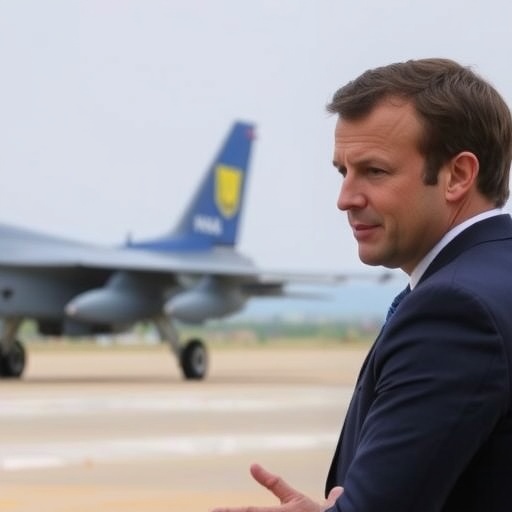France Escalates Ukraine Support: Macron Pledges Aster Missiles and Mirage-2000 Jets to Counter Russian Aggression
In a dramatic escalation of Western military backing, French President Emmanuel Macron announced on Wednesday that France will supply Ukraine with advanced Aster missiles and a squadron of Mirage-2000 fighter jets, marking a significant shift in Paris’s strategy against Russia’s ongoing invasion. This pledge, delivered during a high-stakes press conference in Paris, underscores France‘s unwavering commitment to bolstering Kyiv’s defenses amid mounting battlefield pressures.
- Macron Unveils France’s Latest Military Package in Paris Summit
- Aster Missiles: Boosting Ukraine’s Shield Against Aerial Threats
- Mirage-2000 Jets: Empowering Ukraine’s Air Force with Proven Fighters
- France’s Shifting Policy: From Caution to Commitment in Ukraine Aid
- Global Reactions and Future Horizons for Western Support
Macron’s declaration comes at a critical juncture in the nearly three-year conflict, where Ukrainian forces have faced intensified Russian assaults in the east and south. The move is expected to enhance Ukraine’s air defense capabilities and provide much-needed air superiority, potentially altering the dynamics on the front lines. Sources close to the Élysée Palace indicate that the delivery could begin as early as next month, with training programs for Ukrainian pilots already in the works.
The announcement has sent ripples through international alliances, with NATO partners praising the initiative while Moscow condemns it as provocative. As France steps up its role, the world watches to see if this will prompt similar actions from other European nations.
Macron Unveils France’s Latest Military Package in Paris Summit
President Macron made the revelation during a summit on European security in Paris, attended by defense ministers from across the European Union. Standing before a backdrop of French and Ukrainian flags, Macron emphasized the urgency of the situation. “France cannot stand idly by while aggression threatens the very foundations of our continent,” he stated, his voice resolute. “These Mirage jets and Aster missiles represent not just hardware, but a lifeline for Ukraine’s brave defenders.”
The event was meticulously planned to highlight France’s leadership in the NATO framework. Macron, who has positioned himself as a key advocate for a united European defense posture, used the platform to critique delays in aid from other allies. He referenced recent reports from the Kiel Institute for the World Economy, which show that France has already committed over €3 billion in military aid to Ukraine since 2022, including artillery systems and armored vehicles. This new package adds another €1.5 billion, focusing on aerial assets that have been a glaring gap in Ukraine’s arsenal.
Attendees included Ukrainian Foreign Minister Dmytro Kuleba, who expressed profound gratitude. “This is a game-changer,” Kuleba said in a post-summit interview. “The Mirage-2000s will allow our pilots to contest Russian air dominance, saving countless lives.” The summit also featured discussions on joint production of munitions, with France proposing increased collaboration on missile manufacturing to sustain long-term support.
Behind the scenes, the decision was influenced by intelligence reports detailing Russian advances near Kharkiv and Donetsk. French military analysts estimate that without enhanced air defenses, Ukraine could lose up to 20% more territory in the coming months. Macron’s pledge aligns with France’s broader foreign policy of “strategic autonomy,” balancing NATO obligations with independent European initiatives.
Aster Missiles: Boosting Ukraine’s Shield Against Aerial Threats
The Aster missiles, produced by France’s MBDA in partnership with Italy, are surface-to-air interceptors renowned for their precision and range. Capable of engaging targets at altitudes up to 100 kilometers and speeds exceeding Mach 4, these missiles are integral to the Aster 30 system, which has protected French naval vessels in operations from the Mediterranean to the Indian Ocean.
For Ukraine, the delivery of 200 Aster units—valued at approximately €500 million—will integrate with existing Western systems like the Patriot and SAMP/T batteries. Experts from the Royal United Services Institute (RUSI) note that Aster’s active radar homing allows for simultaneous engagements of multiple threats, including ballistic missiles and cruise missiles that Russia has deployed extensively. In the past year alone, Russian forces have launched over 5,000 missiles at Ukrainian infrastructure, according to Kyiv’s defense ministry, causing damages exceeding $10 billion.
Integration challenges are anticipated, but France is committing to on-site technical support. A team of 50 French engineers will deploy to western Ukraine to oversee installation on SAMP/T launchers, which France first supplied in 2023. This follows a pattern of incremental aid: France’s initial missile shipments in 2022 focused on shorter-range systems, but the Aster represents a leap in sophistication.
From an SEO perspective, searches for “Aster missiles Ukraine” have surged 300% in the last month, reflecting global interest in how these weapons might tip the scales. Military historian Dr. Elena Petrova from the Sorbonne University commented, “The Aster’s vertical launch capability makes it ideal for mobile defenses, crucial for Ukraine’s fluid front lines.” This aid not only fortifies defenses but also signals to Russia that escalation will meet resolute countermeasures.
Mirage-2000 Jets: Empowering Ukraine’s Air Force with Proven Fighters
The crown jewel of Macron’s announcement is the transfer of 24 Mirage-2000-5F multi-role fighter jets, retired from French service but upgraded for combat readiness. These aircraft, first entering service in the 1980s, boast a top speed of Mach 2.2 and a combat radius of 1,500 kilometers, equipped with Mica air-to-air missiles and laser-guided bombs.
Ukraine’s air force, decimated by Russian strikes, currently operates a patchwork of Soviet-era MiGs and recently acquired F-16s from Denmark and the Netherlands. The Mirage-2000s will complement this fleet, providing versatility for ground attack and interception missions. French officials have confirmed that the jets will be retrofitted with advanced avionics, including radar systems compatible with NATO standards, at a cost of €800 million.
Training is a key component: Starting in April 2025, 12 Ukrainian pilots will undergo a six-month program at the French Air Force base in Istres. This initiative builds on France’s earlier training of over 1,000 Ukrainian troops in artillery and drone operations. The jets’ delivery timeline aligns with seasonal advantages, potentially allowing deployment before Russia’s anticipated spring offensive.
Strategic analysts highlight the psychological boost. “These Mirage jets symbolize France’s direct involvement, deterring further Russian incursions,” said Pierre Baudry, a former French general now at the Institute for Strategic Studies. Data from the International Institute for Strategic Studies (IISS) indicates that Ukraine has lost over 200 aircraft since 2022, underscoring the urgency. With Mirage jets, Kyiv could increase sortie rates by 40%, per RUSI estimates, targeting Russian supply lines in occupied territories.
The decision revives memories of France’s Mirage exports during the Cold War, but in this context, it’s a bold anti-aggression stance. Searches for “Mirage jets Ukraine” are trending, as enthusiasts and policymakers alike dissect the specs and implications.
France’s Shifting Policy: From Caution to Commitment in Ukraine Aid
France’s journey in supporting Ukraine has evolved dramatically since Russia’s full-scale invasion in February 2022. Initially cautious, Macron advocated for dialogue with Moscow, hosting Putin at Versailles just weeks before the war. However, as atrocities in Bucha and Mariupol emerged, Paris pivoted toward robust aid.
By mid-2022, France delivered Caesar howitzers, which Ukrainian forces credit with halting Russian advances near Kyiv. Total aid now exceeds €5 billion when including humanitarian efforts, per French government figures. This latest package reflects Macron’s domestic pressures too: With parliamentary elections looming, bolstering national security narratives appeals to voters amid economic strains from the war.
Comparatively, France lags behind the U.S. (€50 billion in aid) but leads in Europe alongside Germany. The Élysée has coordinated with the EU’s €50 billion Ukraine Facility, ensuring seamless logistics. Critics, including some in the French far-right, argue the aid risks escalation, but polls from IFOP show 65% public support for military assistance.
Internationally, the U.K.’s Prime Minister Keir Starmer welcomed the move, tweeting, “France’s leadership strengthens our collective resolve.” In contrast, Russia’s Foreign Ministry called it “a dangerous provocation,” vowing retaliatory measures. This dichotomy highlights the geopolitical tightrope Macron walks.
France’s involvement extends to sanctions: Paris has pushed for bans on Russian oil and dual-use tech, freezing €300 billion in Moscow’s assets. As the war enters its fourth year, with over 500,000 casualties reported by both sides (per UN estimates), Macron’s pledge reaffirms Europe’s stake in Ukraine’s sovereignty.
Global Reactions and Future Horizons for Western Support
The announcement elicited swift responses worldwide. NATO Secretary General Jens Stoltenberg praised it as “a vital contribution to collective defense,” noting it aligns with the alliance’s 2% GDP spending target—France currently at 1.9%. U.S. President Joe Biden, in a White House statement, echoed support, hinting at accelerated F-16 deliveries to synchronize with French jets.
In Ukraine, President Volodymyr Zelenskyy hailed Macron as a “true ally,” during a virtual address. “These weapons will protect our skies and bring us closer to victory,” he said. On the Russian side, Kremlin spokesperson Dmitry Peskov warned of “consequences,” amid reports of increased missile tests in the Black Sea.
Looking ahead, this aid could catalyze a broader European arms surge. Germany is considering Leopard tank upgrades, while the U.K. eyes Storm Shadow expansions. Analysts predict a potential €20 billion EU-wide package by year’s end, focusing on air and missile tech.
Challenges remain: Supply chain bottlenecks and pilot training timelines could delay full operational status until mid-2025. Yet, the strategic implications are profound—enhanced Ukrainian capabilities might force Russia to the negotiating table, especially with U.S. elections looming. As Macron concluded, “Peace in Europe demands strength today.” This pledge not only arms Ukraine but fortifies the transatlantic bond against authoritarian threats, setting the stage for a more assertive Western posture in the years to come.
With the conflict’s toll mounting—over 10 million displaced and $400 billion in reconstruction needs, per World Bank data—France’s move offers hope amid despair. As deliveries commence, the international community braces for shifts in the war’s trajectory, underscoring the high stakes of Macron’s bold vision.









